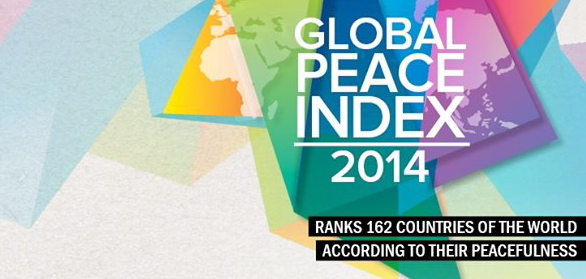The 2014 Global Peace Index

The 2014 Global Peace Index shows that the world is becoming a less peaceful place. This decline follows a seven-year trend of decreases in peace, with 51 countries improving in peace and 111 deteriorating since 2008.
The Global Peace Index is the world’s leading measure of global peacefulness. It looks at the levels of domestic and international conflict, safety and security in society and militarisation in 162 countries. The report, now in its seventh year, is produced by the Institute for Economics and Peace a non-partisan, non-profit research organisation seeking to better understand the interaction between peace, the economy and human development.
2014 Results
This year’s report shows continuing deterioration in worldwide peacefulness last year. The decline this year is largely due to global increases in terrorist activity, the number of conflicts fought and the number of refugees and displaced people. This confirms a seven-year gradual, but significant downward slide, which overturns a 60-year trend of increasing global peacefulness dating back to the end of the Second World War.
The most peaceful region of the world continues to be Europe while the least peaceful region is South Asia. Afghanistan has been displaced at the bottom of the index by Syria due to a slight improvement in its peace while Syria continued to deteriorate. South Sudan experienced the largest drop in the index this year falling to 160th and now ranking as the third least peaceful country. Major deteriorations also occurred in Egypt, Ukraine and Central African Republic. Iceland maintains its status as the most peaceful country in the world. Georgia showed the largest improvement in peace levels.
New Zealand, as the fourth most peaceful country in the world, continues to outrank Australia and is still the most peaceful country in the Asia-Pacific region. Australia is ranked the 15th most peaceful country in the world in the 2014 Global Peace Index. Australia is behind the eighth ranked Japan and so remains the third most peaceful country in the Asia-Pacific region. Australia has improved in peace slightly over the last year as improvements from lessening levels of violent crime and reduced terrorist activity offset deteriorations due to increased imports of weapons and increased heavy weapon capabilities.
How much does violence cost?
The economic impact of containing and dealing with the consequences of global violence last year was estimated to be US$9.8 trillion. This is equivalent to 11.3% of global GDP – equal to twice the size of the 54 countries in the African economy.
The economic impact of containing and dealing with the consequences of Australia’s levels of violence was estimated to cost the national economy around US$40 billion in 2013. This is equivalent to 4% of Australia’s GDP, or US$1,760 per person.
Countries at risk
This year’s Global Peace Index includes a new statistical modelling risk tool which identifies countries at risk of descending into violence and unrest in the next two years. The new methodology analyses a data set stretching back to 1996 and compares countries with the performance of states with similar institutional characteristics.
The ten countries most likely to deteriorate in peace in the next two years are Zambia, Haiti, Argentina, Chad, Bosnia and Herzegovina, Nepal, Burundi, Georgia, Liberia and World Cup 2022 host Qatar.
For more information read the report or use the interactive map to compare countries in the index.
Camilla Schippa is Director of the Institute for Economics and Peace.


